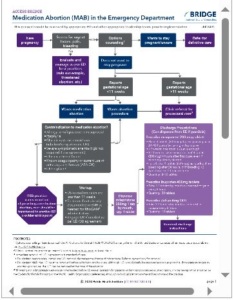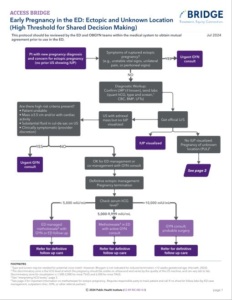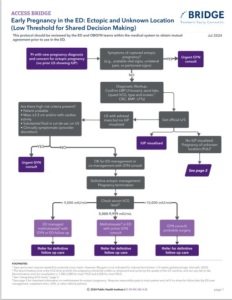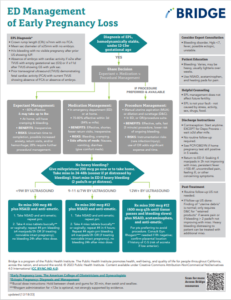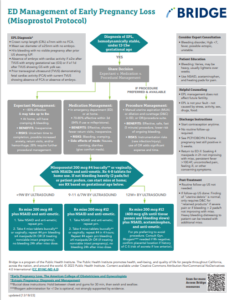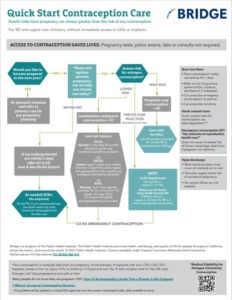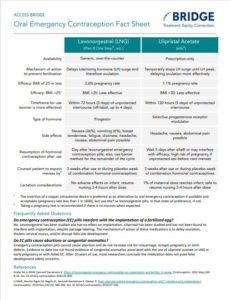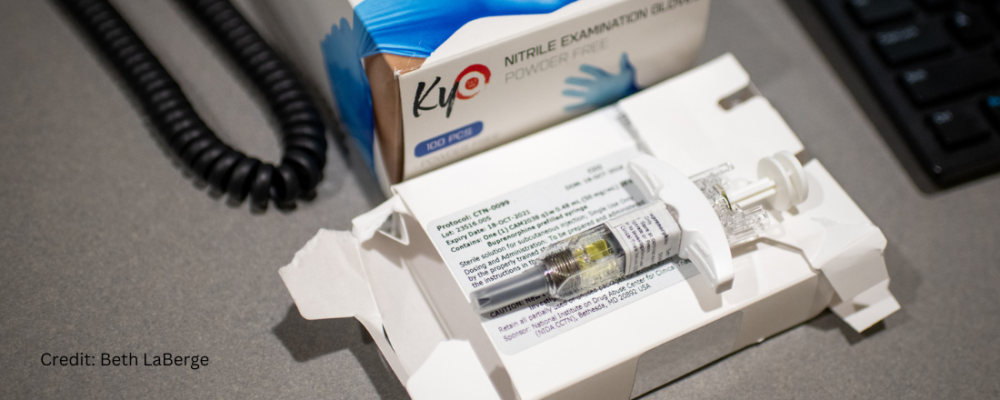
Clinical Guides: ED Management of Medication Abortion, Ectopic Pregnancy, Early Pregnancy Loss and Contraceptive Care
- Access Bridge
-
Focus Areas
Health Care & Population Health, Women, Youth & Children -
Issues
Reproductive & Sexual Health -
Programs
Bridge

Across the country, millions of women live in contraception and reproductive healthcare deserts. Lower-income patients and patients of color are disproportionately impacted, especially in states where there are primary care and OB-GYN provider shortages.
Emergency departments are uniquely positioned to be a safety net for sexual and reproductive health services: EDs are open 24/7, available in most communities and staffed by clinicians trained to manage multiple specialties. Many sexual and reproductive health needs can be met quickly and easily in these settings. And, in light of the alarming restrictions on reproductive rights, healthcare providers have a moral imperative to make legal reproductive health services widely available.
Access Bridge, a project of PHI’s Bridge, works to improve access to sexual and reproductive health services by integrating them into EDs. Access Bridge has developed clinical resources for emergency department providers, including:
- Medication Abortion (MAB) in the Emergency Department
- Early Pregnancy in the ED: Ectopic and Unknown Location
- Emergency Department Protocols for Management of Early Pregnancy Loss
- Emergency Department Protocols and Resources for Contraception and Emergency Contraceptive Care
These protocols were developed by a team of specialists in emergency medicine, family medicine, obstetrics-gynecology, midwifery and nursing. They are being tested in multiple states and will be updated periodically. They should never be used as a substitute for clinical judgment. Providers are responsible for assessing the unique circumstances and needs of each case. Adherence to these guidelines will not ensure successful treatment in every situation.
Medication Abortion (MAB) in the Emergency Department
A clinical guide and chart for medical providers on medication abortion protocols in the emergency department. See the guide.
Early Pregnancy in the ED: Ectopic and Unknown Location
Early Pregnancy in the ED: Ectopic and Unknown Location (High Threshold for Shared Decision Making)
Last updated: July 2024
A clinical guide and protocols chart for ED medical providers on early ectopic pregnancy and unknown location for high threshold for shared decision making. Includes information on Methotrexate, risk factors for ectopic pregnancy and notes on patient education. See the guide.
Early Pregnancy in the ED: Ectopic and Unknown Location (Low Threshold for Shared Decision Making)
A clinical guide and protocols chart for ED medical providers on early ectopic pregnancy and unknown location for low threshold for shared decision making. Includes information on Methotrexate, risk factors for ectopic pregnancy and notes on patient education. See the guide.
Emergency Department Protocols for Management of Early Pregnancy Loss
Access Bridge’s guidance on diagnosing and treating early pregnancy loss is the first of its kind for emergency providers. The variations in these protocols reflect how different political landscapes affect access to mifepristone—a drug that blocks a hormone called progesterone that is needed for a pregnancy to continue.
ED Management of Early Pregnancy Loss
Last updated: March 2024
A clinical guide and chart for diagnosing and managing early pregnancy loss in the Emergency Department. Includes EPL diagnosis, expectant management, medication management, procedure management and more. See the guide.
ED Management of Early Pregnancy Loss (Misoprostol Protocol)
Last updated: March 2024
A clinical guide and chart for diagnosing and managing early pregnancy loss in the ED for sites without access to mifepristone. Includes EPL diagnosis, expectant management, medication management, procedure management and more. See the guide.
Emergency Department Protocols and Resources for Contraception and Emergency Contraceptive Care
These clinical resources from PHI’s Access Bridge are designed for Emergency Department (ED) physicians, providing guidance on contraception and emergency contraceptive care in the ED setting.
Quick-Start Contraception and Emergency Contraceptive Care
A clinical guide for ED and urgent care clinicians, without immediate access to IUDs or implants. See the guide.
Oral Emergency Contraception Fact Sheet
This fact sheet includes clinical comparison information for Ella, Plan B and One Step, as well as FAQs for medical providers and their patients. See the fact sheet.
Originally published by Bridge
Work With Us
You change the world. We do the rest. Explore fiscal sponsorship at PHI.
Support Us
Together, we can accelerate our response to public health’s most critical issues.
Find Employment
Begin your career at the Public Health Institute.
